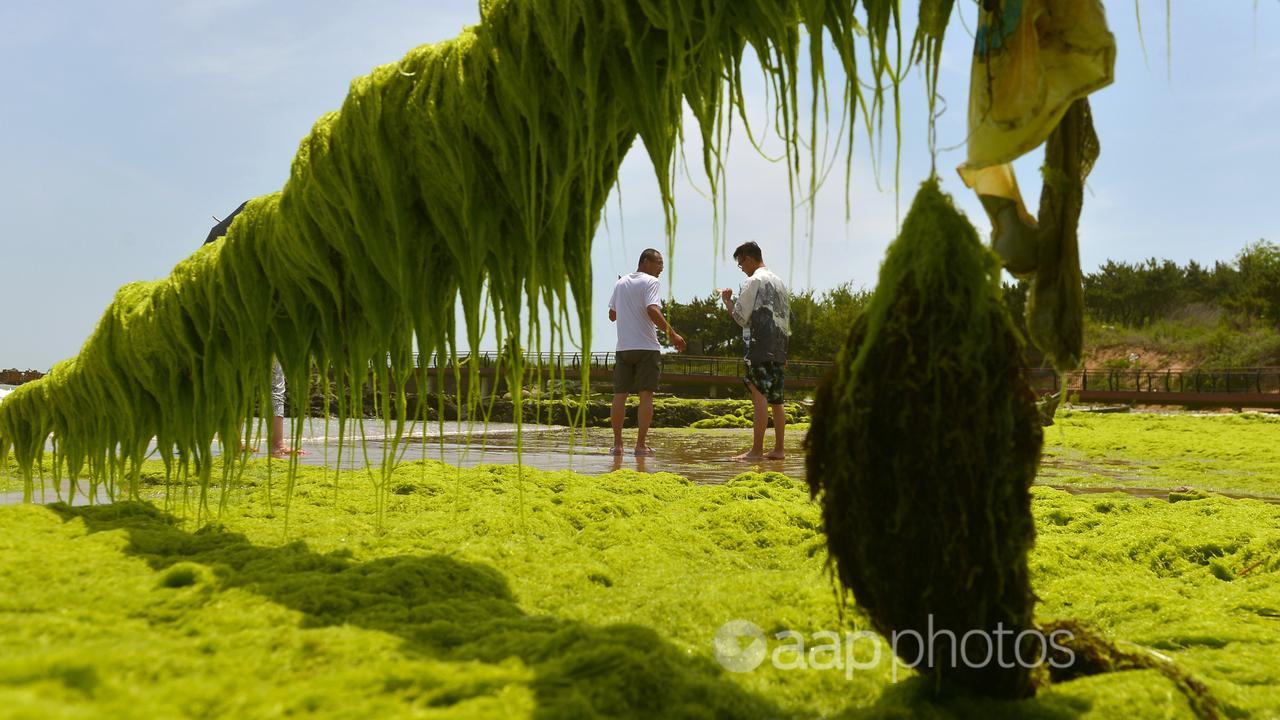Climate scientists are calling for coal-fired power stations to be phased out, but federal MP Bob Katter has proposed an unexpected alternative – funnelling their emissions into giant algae ponds.
In a plan the Katter’s Australia Party leader has promoted on social media, in press conferences, and in parliamentary debate, carbon dioxide emissions from burning coal would be captured and pumped into ponds to feed algae.
While algae stores CO2, experts told AAP FactCheck the emissions the aquatic plants could realistically capture is a fraction of what a coal-fired power station generates, requiring a scale that’s not technically or economically feasible.
Mr Katter spruiked the plan on ABC’s Q+A program on April 21 in the coal industry heartland of Gladstone, south of his Queensland electorate.
“I’ll betcha you have not read the report by the university that did the studies on algae. You can take all of the CO2 from a coal-fired power station and have it absorbed by algae in ponds. They won the United Nations prize for the environment … you can take all of the emissions from a coal-fired power station, grow algae and make more money off the algae than you will off the electricity, with zero emissions,” he said (video mark 29min).
The prize Mr Katter referenced is a UN World Environment Day award James Cook University researchers won in 2015 for sustainable water management.
When contacted Mr Katter’s office pointed AAP FactCheck to Professor Rocky de Nys, a researcher and co-author of the study which looked at capturing wastewater and emissions from the Tarong coal-fired power station.
The study found the algae had some potential for cleaning contaminants from coal plant wastewater, but was not feasible for capturing emissions.
According to the study, the 700MW power station generates 1.5 million tonnes a year of carbon emissions, and the 200-hectare pond available for the site would only be able to capture less than 0.01 per cent of its emissions.
The researchers noted the energy required to grow algae “increases with scale”, and only algae plantations smaller than 500 hectares are likely to achieve net carbon capture – much smaller than what’s needed to offset an entire coal-fired power plant.
“While the integrated cultivation of algae is a commonly cited technique for biological (carbon) capture, our data from a scaled in situ system demonstrate that (carbon) capture relative to emissions from a power station are negligible when realistic scales of algal cultivation and biomass productivities are evaluated,” the study notes.
Prof de Nys told AAP FactCheck in an email the CO2 emissions which “could be captured was negligible when the scale was realistic”.
However, he said the results for cleaning wastewater were promising, and if a higher productivity approach could be devised in future at a larger scale for emissions, there could be a “more meaningful contribution”.
A 2017 International Energy Agency analysis found nearly 36,000 hectares of algae would be needed to offset a 800MW coal plant – the equivalent of the surface area of almost seven Sydney Harbours.
But the researcher noted this was not feasible, as algae absorbs different rates of CO2 depending on the light available at different times of year, and doesn’t absorb any CO2 at night.
Factoring in slowed production caused by routine maintenance or contaminants, the study found this solution would absorb about 18 per cent of annual power plant emissions from a 10,800 hectare space – much larger than the report’s envisioned algae production site of between 400-2000 hectares.
To completely offset a coal plant’s emissions, the algae would need to be put to use in a way that does not release the absorbed carbon – ruling out burning the algae for energy, using it in fuel, or just letting it die.
Professor Michael Borowitzka, an algae expert at Murdoch University, told AAP FactCheck making biochar compost from the algae – one of the options suggested in the paper – creates CO2 during production.
Prof Borowitzka said another challenge would be finding enough flat land and water near the coal-fired power station.
“CO2 fixation by algae can be a partial solution to reduce CO2, but given the scale of CO2 production by coal-fired power stations the impact is very small to trivial,” he said in an email.
University of Queensland algae expert Evan Stephens told AAP FactCheck other proposals to sell the algae for livestock feed were also inadvisable.
“Even if the carbon dioxide piped to the algae farm was scrubbed (cleaned) of any contaminants, the emissions from the power plant itself will fall/settle in a large radius around the power plant – so all of the algae ponds would be absorbing these toxins, and concentrating them in the algae biomass,” Dr Stephens said in an email.
“So it could not be fed to humans or animals, and should not be used as biofertiliser as that would subsequently contaminate crops.”
Dr Stephens said the idea of absorbing all CO2 from a coal plant was not technically or economically feasible, and to even capture a small amount would cost billions of dollars.
“This proposal is a return to a persistent hype that keeps returning that algae can do anything and can save the world. Algae can be utilised to do many great things, but this is not one of them,” he said.
The Verdict
Mr Katter’s claim all carbon emissions from a coal-fired power plant can be stored in algae ponds is not technically or economically feasible. Experts told AAP FactCheck the ponds would have to be impractically large, and would only capture a fraction of the emissions. There are also problems in ensuring the carbon in the algae is not released later, counteracting the aim of zero emissions.
False – The claim is inaccurate.
* Editor’s note: AAP FactCheck has expanded its ability to fact-check environmental issues with the support of the Australian Conservation Foundation. AAP FactCheck retains full editorial independence in this project and continues to apply the rigorous standards required for accredited members of the International Fact-Checking Network.
All information, text and images included on the AAP Websites is for personal use only and may not be re-written, copied, re-sold or re-distributed, framed, linked, shared onto social media or otherwise used whether for compensation of any kind or not, unless you have the prior written permission of AAP. For more information, please refer to our standard terms and conditions.


















